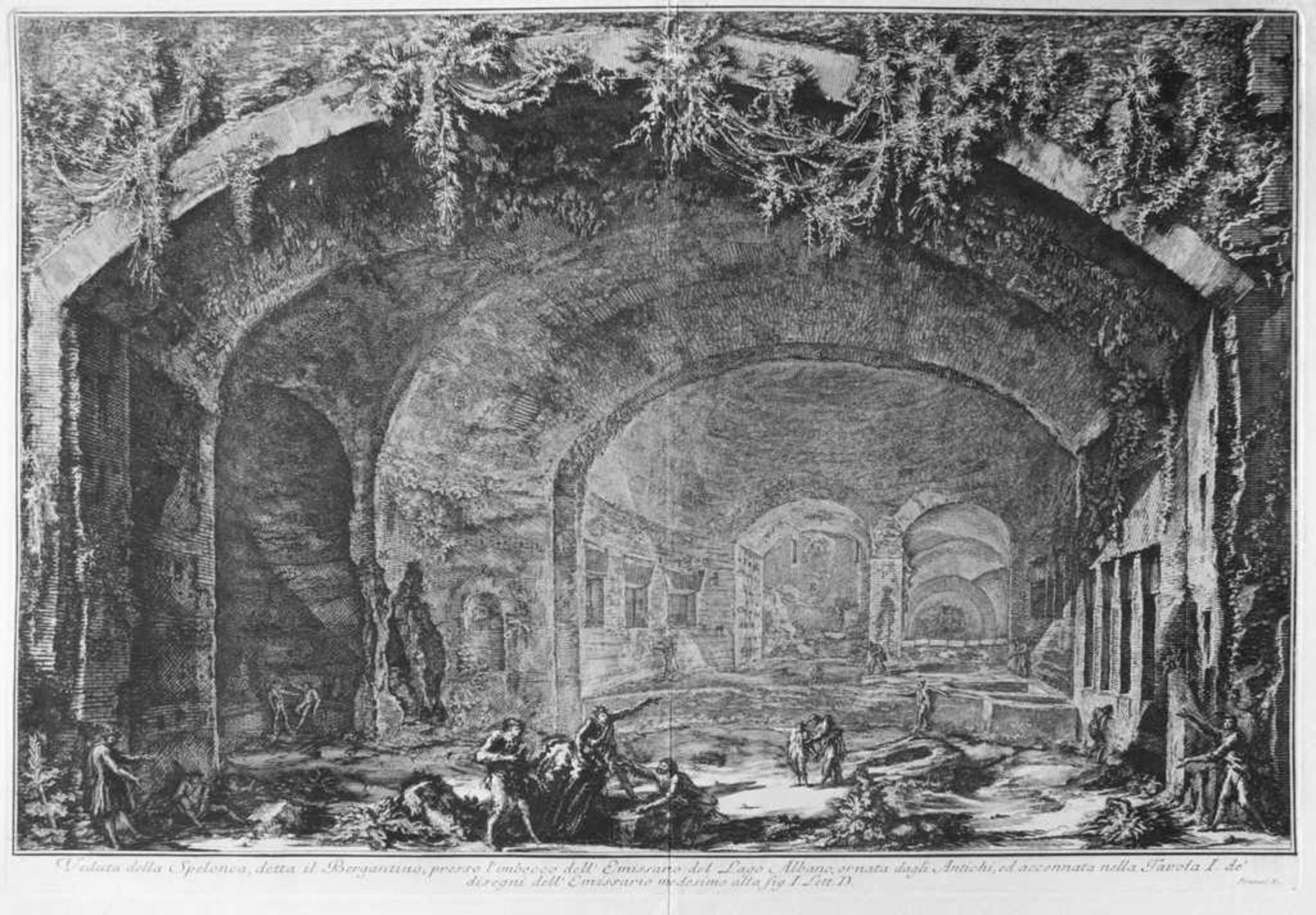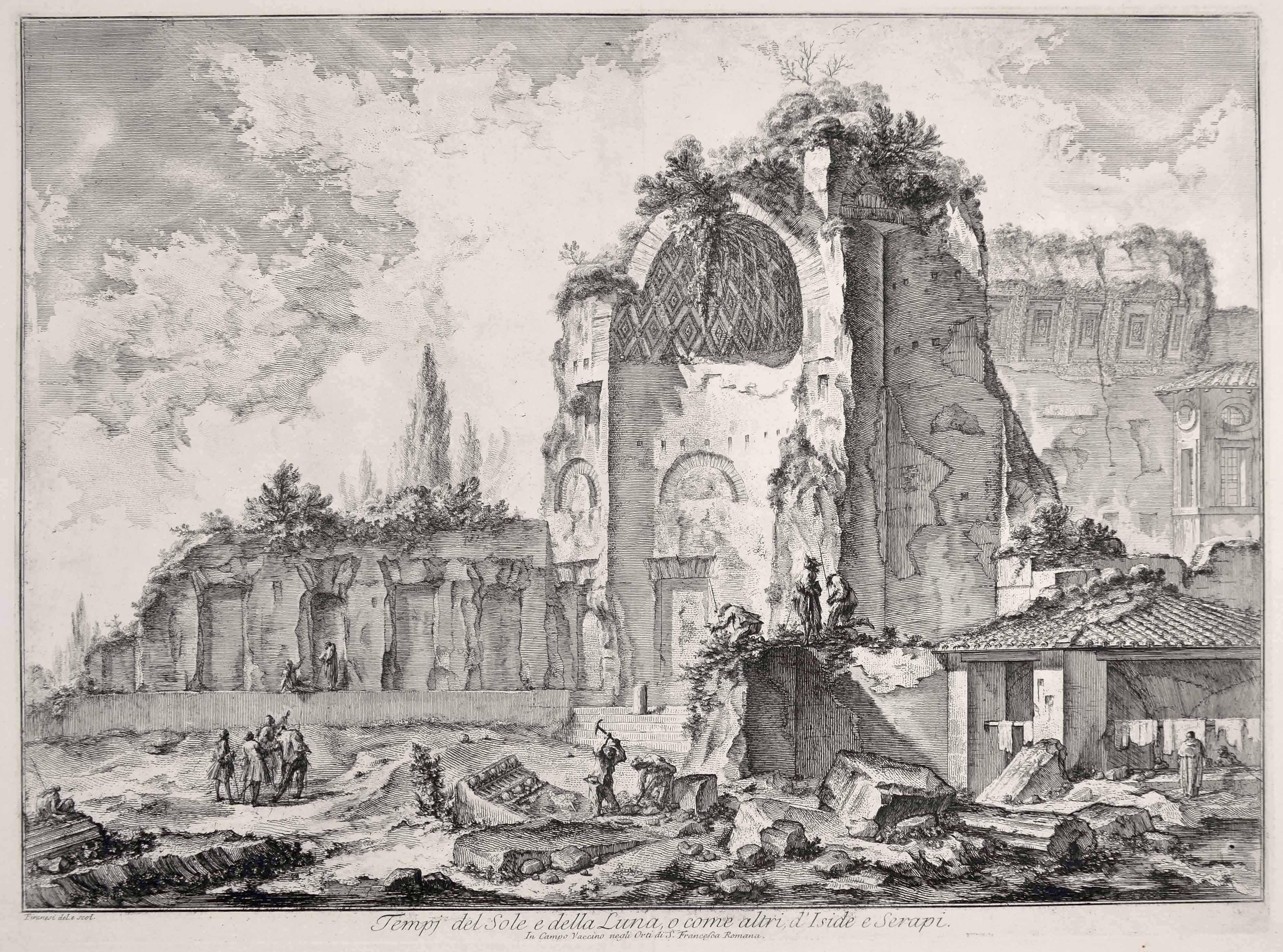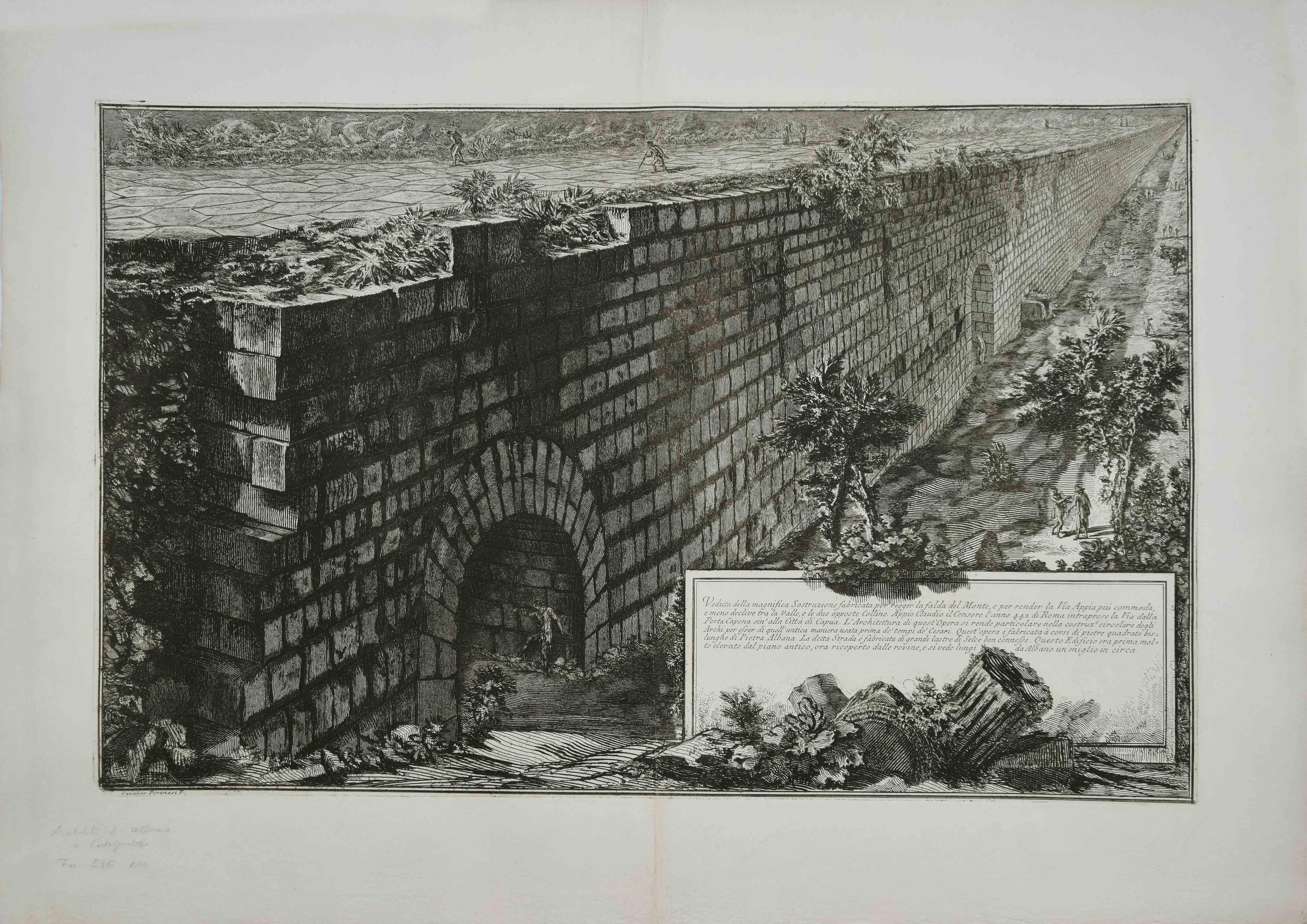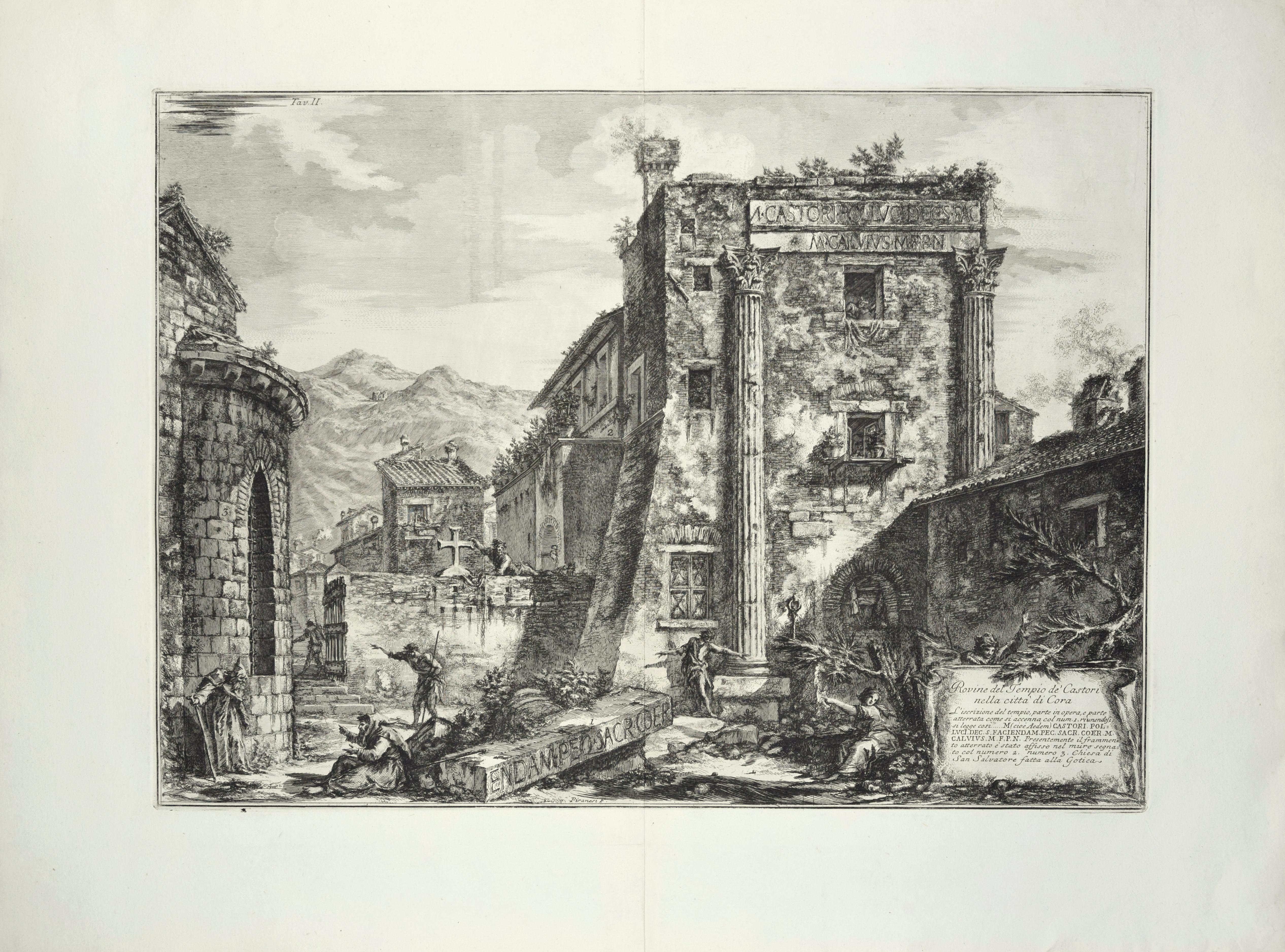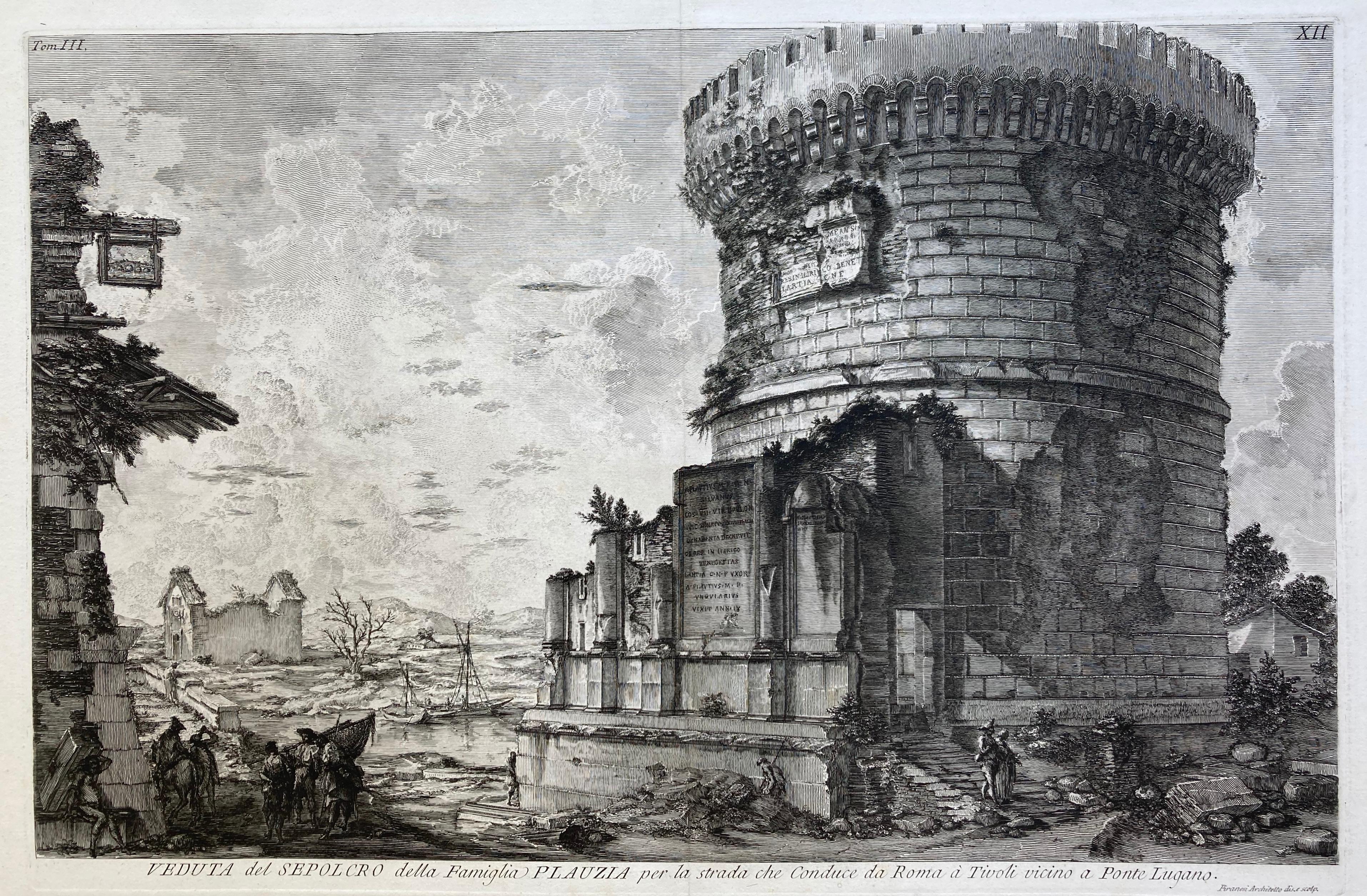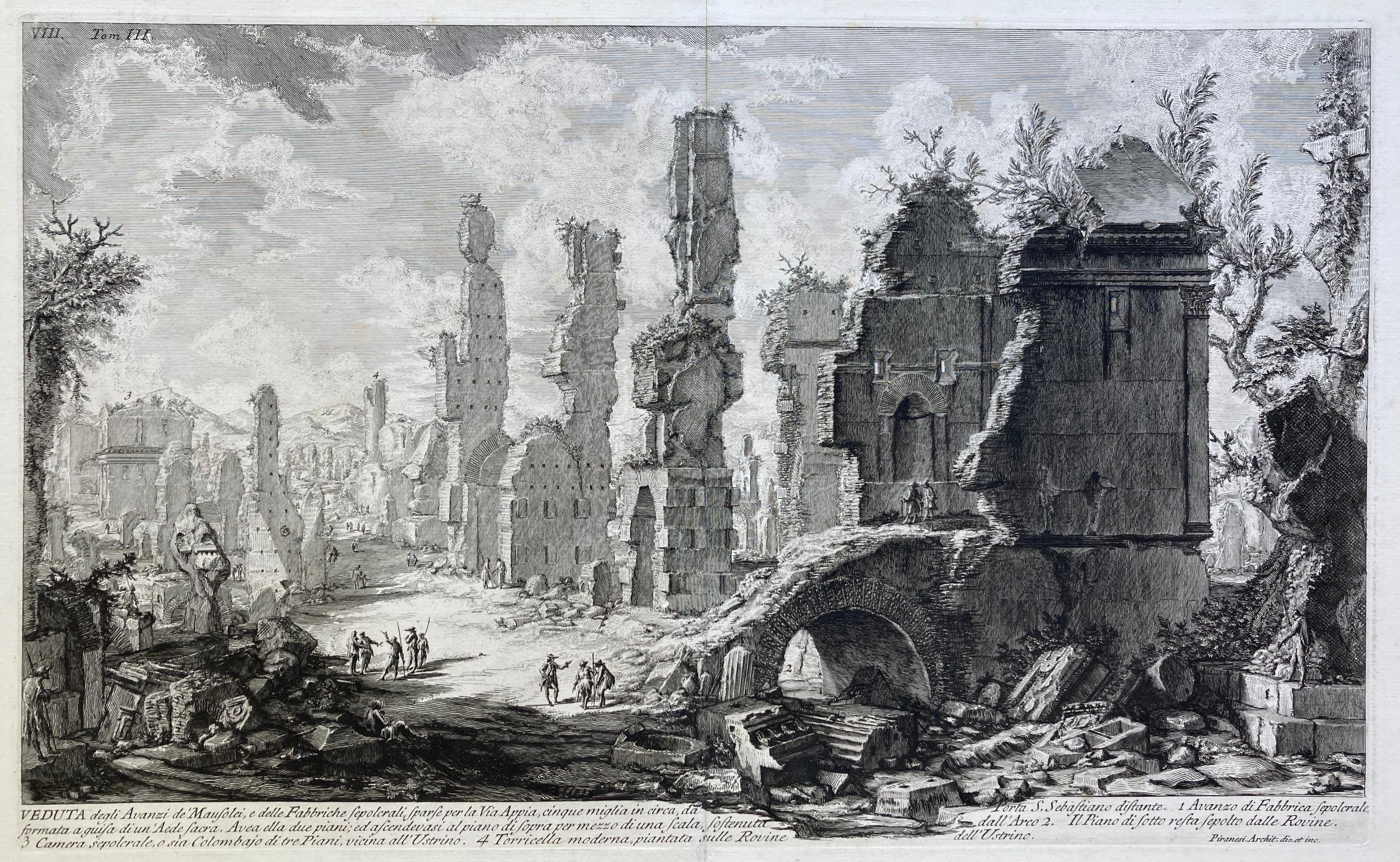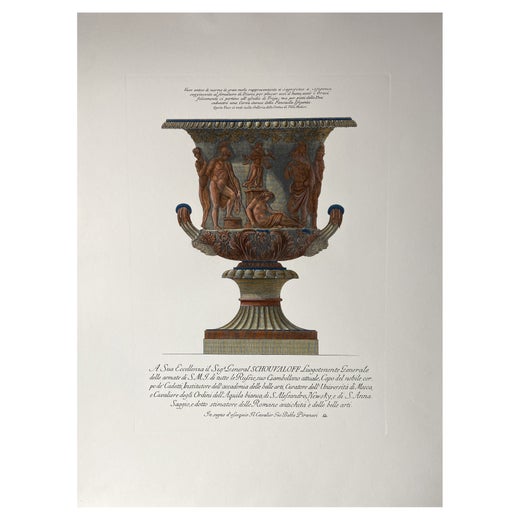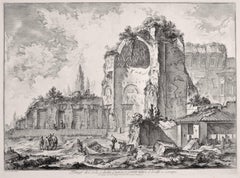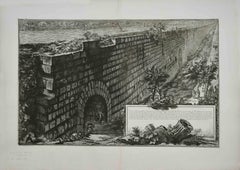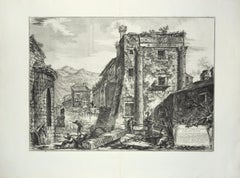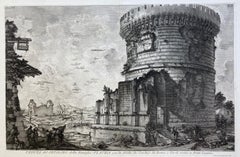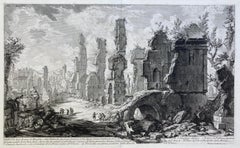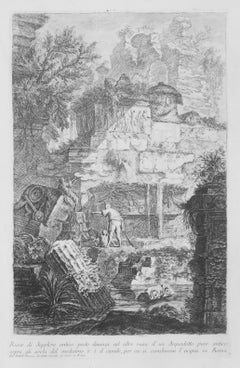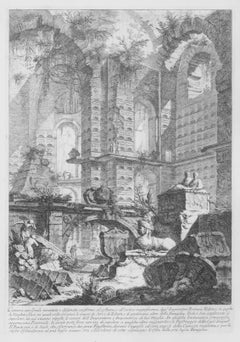Items Similar to Sepolcro Regio, o Consolare , inciso nella rupe... - G. B. Piranesi - 1764
Want more images or videos?
Request additional images or videos from the seller
1 of 5
Giovanni Battista PiranesiSepolcro Regio, o Consolare , inciso nella rupe... - G. B. Piranesi - 17641764
1764
$3,777.39
£2,837.68
€3,200
CA$5,294.41
A$5,750.69
CHF 3,044.51
MX$69,436.04
NOK 38,007.62
SEK 36,006.18
DKK 24,372.02
About the Item
Sepolcro Regio, o Consolare , inciso nella rupe del Monte Albano (Royal or Consular Tomb in the Alban Hills) is an original etching realized by Giovan Battista Piranesi in 1764.
Edition Rome 1764. Title engraved on the title page: Antiquities of Albano and of Castel Gandolfo described and etched by Gio. Battista Piranesi. Date engraved on lower left margin of title page: In Roma l'Anno 1764.
Volume Composed of a title page, dedication to Pope Clement XIII, an ornamented letter, a vignette, 26 plates and 26 pages of text, preceded by a 2-page printed dedication.
This artwork is published on the general catalogue “Piranesi: The Complete Etchings”. by Luigi Ficacci, Taschen, Italy, 2000, p. 456, n. 563.
This artwork is shipped from Italy. Under existing legislation, any artwork in Italy created over 70 years ago by an artist who has died requires a licence for export regardless of the work’s market price. The shipping may require additional handling days to require the licence according to the final destination of the artwork.
- Creator:Giovanni Battista Piranesi (1720-1778, Italian)
- Creation Year:1764
- Dimensions:Height: 26.78 in (68 cm)Width: 31.5 in (80 cm)Depth: 0.04 in (1 mm)
- Medium:
- Period:1760-1769
- Framing:Framing Options Available
- Condition:Insurance may be requested by customers as additional service, contact us for more information.
- Gallery Location:Roma, IT
- Reference Number:Seller: J-674491stDibs: LU65037501932
Giovanni Battista Piranesi
Piranesi was born in Venice in 1720 and died in Rome in 1778. He was the son of a stone mason and was trained as an architect. After a slow start he eventually achieved great success as an architect, archaeologist, artist, designer, collector, and antiquities dealer. His mission was to glorify the architecture of ancient Rome through his engravings and etchings. His highly dramatized prints often depict imaginary interiors and frequently include figures in mysterious activities, who are dwarfed by the magnitude of their monumental surroundings. Piranesi's style greatly influenced the neoclassical art movement of the late 18th century. His dramatic scenes inspired generations of set designers, as well as artists, architects and writers. His prints have continued to increase in value to institutions and collectors.
About the Seller
4.9
Platinum Seller
Premium sellers with a 4.7+ rating and 24-hour response times
1stDibs seller since 2017
7,742 sales on 1stDibs
Typical response time: 2 hours
- ShippingRetrieving quote...Shipping from: Roma, Italy
- Return Policy
Authenticity Guarantee
In the unlikely event there’s an issue with an item’s authenticity, contact us within 1 year for a full refund. DetailsMoney-Back Guarantee
If your item is not as described, is damaged in transit, or does not arrive, contact us within 7 days for a full refund. Details24-Hour Cancellation
You have a 24-hour grace period in which to reconsider your purchase, with no questions asked.Vetted Professional Sellers
Our world-class sellers must adhere to strict standards for service and quality, maintaining the integrity of our listings.Price-Match Guarantee
If you find that a seller listed the same item for a lower price elsewhere, we’ll match it.Trusted Global Delivery
Our best-in-class carrier network provides specialized shipping options worldwide, including custom delivery.More From This Seller
View AllVeduta della Spelonca, detta il Bergantino - Etching by G. B. Piranesi - 1762
By Giovanni Battista Piranesi
Located in Roma, IT
Veduta della Spelonca, detta il Bergantino is an original etching realized by G. B. Piranesi in 1762.
Image Dimensions: 43 x 63 cm
Very good condition.
Ref. Ficacci., p.442
Category
1760s Landscape Prints
Materials
Etching
Temples of Iside and Serapi - Etching by G. B. Piranesi - 1759
By Giovanni Battista Piranesi
Located in Roma, IT
Temples of Iside and Serapi is an etching realized by the italian artist Giovanni Battista Piranesi in 1759.
Image dimensions: 41.5 x 55.5 cm.
Very precious lifetime impression. C...
Category
1750s Figurative Prints
Materials
Etching
Veduta della Magnifica Sostruzione Fabricata - Etching by G. B. Piranesi -1760s
By Giovanni Battista Piranesi
Located in Roma, IT
View of the magnificent substructure is an original etching realized by the italian artist Giovanni Battista Piranesi.
Very precoius and rare specimen. Roman edition.
Complete tit...
Category
Late 18th Century Figurative Prints
Materials
Etching
Rovine del Tempio de' Castori nella città di Cora - Etching by G. B. Piranesi
By Giovanni Battista Piranesi
Located in Roma, IT
Image dimensions 40.6x56.8.
Belongs to the Collection "Antiquities of Cori, described and etched by Giovambat Piranesi", and printed in 1764.
Beautiful first roman edition/1st state ...
Category
1760s Landscape Prints
Materials
Etching
Veduta degli Avanzi sopra terra dell'antico Ustrino - Etching by G. B. Piranesi
By Giovanni Battista Piranesi
Located in Roma, IT
Image dimensions 40x60.
Veduta degli Avanzi sopra terra dell’antico Ustrino (View of the visible remains of the ancient crematorium) is a wonderful black and white etching on thick...
Category
1750s Landscape Prints
Materials
Etching
Ruins of an Ancient Tomb - G. B. Piranesi - 1762
By Giovanni Battista Piranesi
Located in Roma, IT
Ruins of an Ancient Tomb is an original etching realized by the italian artist Giovanni Battista Piranesi in 1762.
Image dimensions: 41.5x56 cm
Very precoius and rare lifetime spec...
Category
1760s Old Masters Figurative Prints
Materials
Etching
You May Also Like
VEDUTA del SEPOLCRO della Famiglia PLAUZIA per la strada che Conduce da Roma....
By Giovanni Battista Piranesi
Located in Santa Monica, CA
GIOVANNI BATTISTA PIRANESI (Italian 1720-1778)
VEDUTA del SEPOLCRO della Famiglia PLAUZIA per la strada che Conduce da Roma a Tivoli vicino a Ponte Lugan...
Category
1750s Old Masters Landscape Prints
Materials
Etching
VEDUTA DEGLI AVANZI De’MAUSOLEI E DELLE FABBRICHE…...
By Giovanni Battista Piranesi
Located in Santa Monica, CA
GIOVANNI BATTISTA PIRANESI (Italian 1720-1778)
VEDUTA DEGLI AVANZI De’MAUSOLEI E DELLE FABBRICHE…c 1756 (Hind 83; Focillon 20.A.293; Giesecke 116; Wilton-E...
Category
1750s Old Masters Landscape Prints
Materials
Etching
$2,000 Sale Price
20% Off
Ruine di Sepolcro antico
By Giovanni Battista Piranesi
Located in Fairlawn, OH
Ruine di Sepolcro antico
Etching, 1743
Signed in the plate bottomleft in the caaption plate
From: Prima Parte, 1743
Second edition: 1750-1778
Watermark: R 37-39
A lifetime impression printed during Piranesi’s life, before the plates are moved to Paris by his sons in the 1790’s
Coniditon: Excellent/Very good
Image size: 14 5/8 x 9 3/4 inches
Reference: Robison 17 iii/V
Piranesi In Rome: Prima Parte di Architetture e Prospettive
"Although Piranesi studied architecture in Venice, he never was able to find work in the field other than a few jobs involving remodeling in Rome. While Piranesi was struggling to support his architectural endeavors upon his arrival in Rome in 1740, he spent a short period of time in the studio of master painter Giovanni Battista Tiepolo (1696-1770) in addition to his apprenticeship with Giuseppe Vasi. The first production of Piranesi’s early years in Rome and a culmination of his training under Vasi, Tiepolo, and his uncle, was the Prima Parte di Architetture e Prospettive (1743). The Prima Parte was a collection of twelve etchings of imaginary temples, palaces, ruins, and a prison. During this time, Piranesi was still developing the unique style of etching he is known for today, and as such the Prima Parte differs significantly in technique compared to later works. In the Frontispiece of the Prima Parte, Piranesi’s lines are definite and exact with very little flow to them, designed in the form of traditional etching. The detail is immaculate, and yet perspective of the piece is oddly simple and familiar to the viewer. Piranesi’s technique employs miniscule markings and lines, intricately woven together to create a stippling effect. The Prima Parte, described as “rigid” by art historian Jonathan Scott, came to be seen as a stark contrast to his later sketches, which were much lighter and freer. Influenced by the style of Tiepolo, which epitomized the lightness and brightness of the Rococo period, Piranesi adopted some of the more painterly techniques of the masters he apprenticed under. Piranesi made the medium of etching appear as though it was a sketch or a painting, hence a “freer” and more fluid design in his later works. For example, the frontispiece of the Prima Parte read as an etching to Piranesi’s audience, but in his later vedute, the style of etching almost appears to be made of brushstrokes. Moreover, at the same time Piranesi was working on the Prima Parte, he aided the artist Giambattista Nolli. There is a small section of Nolli’s map...
Category
1740s Old Masters Interior Prints
Materials
Etching
Camera sepolcrale
By Giovanni Battista Piranesi
Located in Fairlawn, OH
Camera sepolcrale
Etching 1743
Signed in the bottom left corner
From: Prima Parte, 1743
Second edition: 1750-1778
Watermark: R 37-39
A lifetime impression printed during Piranesi’s life, before the plates are moved to Paris by his sons in the 1790’s
Condition: Excellent
Image size: 14 5/8 x 9 3/4 inches
Reference: Robison 20 iii/V
Piranesi In Rome: Prima Parte di Architetture e Prospettive
"Although Piranesi studied architecture in Venice, he never was able to find work in the field other than a few jobs involving remodeling in Rome. While Piranesi was struggling to support his architectural endeavors upon his arrival in Rome in 1740, he spent a short period of time in the studio of master painter Giovanni Battista Tiepolo (1696-1770) in addition to his apprenticeship with Giuseppe Vasi. The first production of Piranesi’s early years in Rome and a culmination of his training under Vasi, Tiepolo, and his uncle, was the Prima Parte di Architetture e Prospettive (1743). The Prima Parte was a collection of twelve etchings of imaginary temples, palaces, ruins, and a prison. During this time, Piranesi was still developing the unique style of etching he is known for today, and as such the Prima Parte differs significantly in technique compared to later works. In the Frontispiece of the Prima Parte, Piranesi’s lines are definite and exact with very little flow to them, designed in the form of traditional etching. The detail is immaculate, and yet perspective of the piece is oddly simple and familiar to the viewer. Piranesi’s technique employs miniscule markings and lines, intricately woven together to create a stippling effect. The Prima Parte, described as “rigid” by art historian Jonathan Scott, came to be seen as a stark contrast to his later sketches, which were much lighter and freer. Influenced by the style of Tiepolo, which epitomized the lightness and brightness of the Rococo period, Piranesi adopted some of the more painterly techniques of the masters he apprenticed under. Piranesi made the medium of etching appear as though it was a sketch or a painting, hence a “freer” and more fluid design in his later works. For example, the frontispiece of the Prima Parte read as an etching to Piranesi’s audience, but in his later vedute, the style of etching almost appears to be made of brushstrokes. Moreover, at the same time Piranesi was working on the Prima Parte, he aided the artist Giambattista Nolli. There is a small section of Nolli’s map...
Category
1740s Old Masters Interior Prints
Materials
Etching
Ancient Roman Architecture: Original Framed 18th C. Etching by G. Piranesi
By Giovanni Battista Piranesi
Located in Alamo, CA
"Veduta del Sepolcro della Famiglia Plauzia per la Strada Che Conduce da Roma a Tivoli vicino a Ponte Lugano" from "Le Antichità Romane" (Roman Antiquities), one of the most famous works by Piranesi. "Antichita" illustrates the tombs along the Appian Way...
Category
Early 18th Century Old Masters Figurative Prints
Materials
Etching, Engraving, Drypoint
Veduta delle Antiche Sostruzioni, Vintage Cityscape Etching by Giovanni Piranesi
By Giovanni Battista Piranesi
Located in Long Island City, NY
Artist: Giovanni Battista Piranesi, Italian (1720 - 1788)
Title: Veduta delle Antiche Sostruzioni
Portfolio: Vedute di Roma
Year: 1776
Medium: Etching
...
Category
1770s Old Masters Landscape Prints
Materials
Etching
More Ways To Browse
Gaetano Dura On Sale
George Grosz On Sale
George Jo Mess
Giovanni Battista Piranesi Vaso Di Marmo Antico Che Si Vede Nel Museo Capitolino Etching 1778
Grace Albee
Gustave Adolph Hoffman On Sale
H Hargrove
H Otsuka
Helen Hyde On Sale
Henri Cartier Bresson Poster
Henri Matisse Plate 4
Henrik Simonsen
Henry Casselli
Henry Moore Elephant
Henry Moore Sheep
Henry Wilkinson Etching
Herbert Matter Vintage Airline Poster
Herman Wessel
